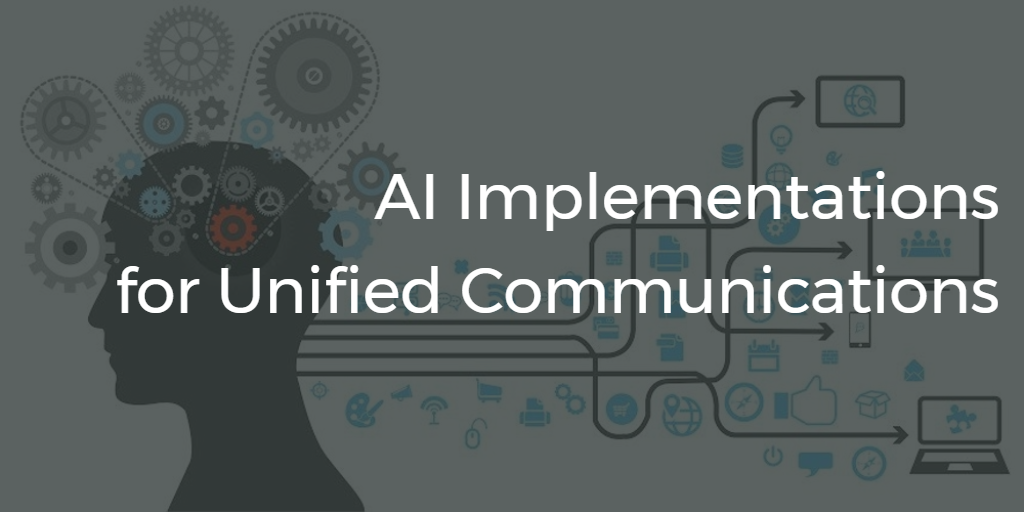AI Implementations For Unified Communications
AI has become quite the buzzword in today’s corporate echelons. It is a promising new technology which when properly implemented offers immense business enhancing advantages to businesses of all sorts and sizes, regardless of their operational industry vertical. Unified communication technology is one such area where AI can be implemented on the grassroot levels to bring unprecedented benefits in terms of automation, collaboration, and much more.
In this blog, we shall highlight a few AI applications which can help our readers to discern how AI influenced unified communication solutions and services can perform well beyond their expected potential.
AI technology, specifically machine learning and predictive analysis can work wonders for unified communication strategies and operational collaboration in general. It provides employees within an organization to manage and share information easily. By implementing AI technology within existing operations, businesses can gain better insights, both ad-hoc and project specific, on how their employees interact with each other and their customers, and optimize accordingly to improve collaboration across the entire organization.
For instance, implementing AI on existing processes gains business the advantage of having all relevant documents and data, based on previous interactions, all collated and ready before anyone needs them. Experts even consider that in the very near future, AI will become sophisticated and complex enough to offer services like Apple’s Siri or Amazon’s Alexa and allows users to interact with AI processes better.
Below we’ve illustrated two distinct examples and the benefits of AI implementation on existing unified communication services and solutions.
Optimized Customer Service
With AI backed unified communication, all previous customer-agent interactions can be displayed to the agent while interacting with customers. This enhances the element of collaboration within call center environments to maintain better customer relationships and helps provide better customer service. It also helps to streamline the entire process of customer-agent interaction and reduces wait times and the time required to guide the customer to a satisfactory answer or solution.
Other areas where AI can be used to streamline conventional customer interaction workflows and processes, like order processing and such. It can also be sued to create smart bots which identify and categorize every customer inquiry, helping the business representatives to respond to customer inquiries quicker, while having all relevant data available beforehand.
A similar type of AI implementation has recently been applied where IBM’s AI Watson and Salesforce’s AI Einstein were combined to optimize customer sales and service engagements and reduced the time required for issue resolution substantially. This was possible due to the fact that AI backed unified communication solutions and services provided business representatives the ability to interact with the callers better by providing them with all the necessary and relevant information to improve customer engagement.
AI Backed Collaboration
When it comes to Unified Communications, AI technology is still fresh off the boat and yet even in the early stages AI implementation within Unified Communications has provided business with the potential to collaborate quicker and in real-time. This holds the potential to bestow upon businesses the ability to keep each stakeholder on the same page and work in tandem with each other, while delivering the best possible caller experience possible.
For example, telecommunication giants Cisco and IBM in June 2016, integrated IBM’s Watson, Verse, and Connections with Cisco’s Spark. This enabled them to create services which work collaboratively to manage and create optimized tasks and workflows, without any human intervention.
Another example of AI backed collaboration as showcased by Microsoft in its Ignite Conference in September 2016 conveys their intent to use their AI service Cortana, using a voice interface to manage all interpersonal communications.
This example, which is very similar to the Cisco-IBM collaboration, may see Cortana being used as a virtual assistant for various interactions, task management, and for providing representatives with all necessary and relevant information in the very near future. It can also be used to store all natural language queries where agents can actually interact with Cortana and ask for information like they would from a living berating person.
These are only a couple of instances where the strategic implementation of AI technology has brought forth humongous collaborative and efficacy related business advantages. Not only can AI backed unified communication offers businesses unprecedented collaborative effectiveness and the ability to deliver better customer service, it will, in the very near future also help create intelligent processes and strategies, which shall reduce human borne inefficiencies and errors.
However, AI technology is still in its early stages, which means that IT companies should sit down with their collaboration and enterprise software vendors and service providers to map out strategies to implement AI within their existing processes and operations. In the very near future, proper and strategic AI implementation will allow businesses which rely on unified communication solutions and services to gain substantial competitive advantage.














Leave a Reply
Want to join the discussion?Feel free to contribute!